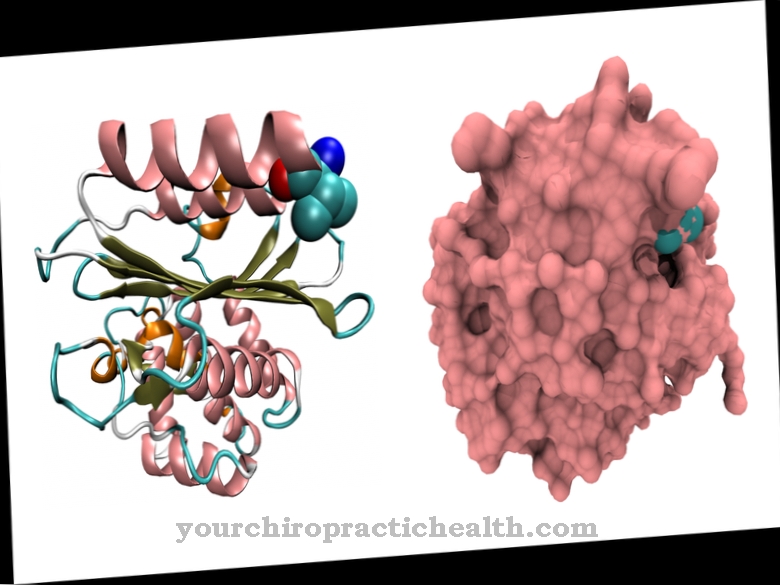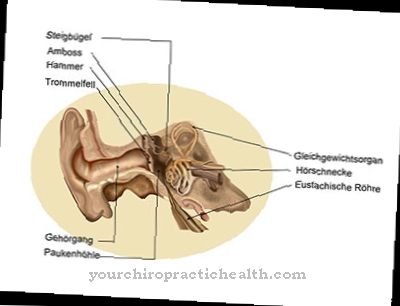About 90 percent of the world population suffers from the Lactose intolerance or. Lactose intolerance. In the countries of Central Europe there are fewer people who suffer from lactose intolerance. Only about 10 to 20 percent of the population with lactose intolerance can be found here.
What is lactose intolerance (milk sugar intolerance)?
Infants and toddlers usually tolerate dairy products one hundred percent without problems. Milk contains the ingredient lactose, which is also called milk sugar. The milk sugar is broken down by the enzyme lactase.
In adulthood, the ability to digest milk sugar in an optimal way slowly decreases. This is how the Lactose intolerance.
Lactose intolerance should not be confused with an allergy to milk protein. Because a lactose intolerance is only a digestive weakness.
causes
Lactose is broken down in the intestine into its components glucose and galactose with the help of lactase. This digestive enzyme is produced in the small intestine. If it is produced inadequately or not at all in the human body, then one speaks of one Lactose intolerance.
The milk sugar can no longer be digested properly. The undigested lactose then migrates to other sections of the intestine that are colonized with another type of intestinal bacteria. These intestinal bacteria feed on the undigested milk sugar. This creates larger amounts of gases and organic acids in the intestine. They also cause water to be retained in the intestines. This causes violent bowel movements.
In the case of primary lactase deficiency, patients suffer from a neonatal lactase deficiency as a result of a metabolic disease. This form of the disease is very rare. The physiological lactase deficiency begins in childhood after weaning. The ability to produce lactase then slowly declines.
The secondary lactase deficiency is triggered by a disease such as Crohn's disease or celiac disease. When the disease is cured, lactose intolerance decreases.
Symptoms, ailments & signs
.jpg)
© designua - stock.adobe.com
The most common symptoms of lactose intolerance (milk sugar intolerance) include unexplained abdominal pain, gas, and diarrhea. These occur after consuming foods and beverages containing lactose. The symptoms can appear immediately after consuming lactose, but also after a delay. How sensitive individual people are depends on the enzyme lactase, which is used to metabolize milk sugar.
The problem is that the symptoms can initially remain inexplicable and diffuse. The organism has to get used to the milk sugar supply. This can make the symptoms less noticeable. They can be "capped" for years and covered by other complaints. The symptoms that occur in this case can include a tendency to gastrointestinal disorders gastrointestinal complaints, abnormal immune problems, sleep disorders or the urge to urinate after consuming lactose-containing foods.
Complaints caused by lactose intolerance can vary from person to person. Some people react to the smallest doses of lactose with severe digestive problems. Other people tolerate foods with a low lactose content, but not those with a higher lactose content. It is difficult to always assign the symptoms that occur to lactose, as this is often hidden under the ingredient "spices" in industrially produced foods.
If lactose intolerance and the accompanying complaints occur in childhood, the causes may be easier to identify than if the intolerance due to an increasing lactase deficiency only becomes apparent in adulthood.
Course of disease
What is she doing Lactose intolerance noticeable? After a meal that contains lactose, patients initially feel full. Flatulence and belching follow. Abdominal pain can range up to colic, but it does not necessarily have to be so drastic. Nausea and diarrhea can also result from lactose intolerance.
There are numerous grades in this disease. Some patients may ingest small amounts of foods containing lactose. This group does not tolerate whole milk, cream or sweet cream butter. Natural yogurt, buttermilk and sour cream butter, on the other hand, are often digested well.
The same goes for cheese. Matured cheeses are better tolerated than cream cheese, for example. Provided that these foods are not consumed in excessive amounts. The lactic acid they contain ensures that the slightly acidified milk products are well tolerated. It does some of the digestive work.
As a rule of thumb, it can be said that a group can consume up to one gram of lactose without any symptoms. Another group can tolerate up to 10 grams of lactose. Only a very small percentage of patients cannot tolerate lactose at all. These patients must ensure that all food and drink as well as medication do not contain lactose.
Complications
As a rule, there are no special or life-threatening complications with lactose intolerance. The life expectancy of the person affected is neither influenced nor reduced due to lactose intolerance. However, lactose intolerance has a negative effect on quality of life, so that the patient has to forego dairy products.
When taking dairy products, there is pain in the stomach and stomach and there is also gas. Not infrequently, this pain can also lead to depression in the long term. Especially at night, the pain can lead to sleep problems and thus to irritation of the patient. However, a causal treatment of lactose intolerance is not possible.
Those affected have to avoid dairy products in their everyday lives or use lactose-free products. This can limit most complaints. The use of supportive medication can also alleviate and limit the symptoms. There are usually no special complications or other complaints. Furthermore, in some cases patients are dependent on supplements to get the missing nutrients from dairy products. However, life expectancy is not negatively affected by lactose intolerance.
When should you go to the doctor?
Persistent digestive problems must always be examined by a doctor. Chronic intestinal problems reduce well-being and can cause secondary diseases that are associated with further complaints. A doctor must therefore be called in if the symptoms described recur or persist. Should there be malnutrition or weight problems in connection with an intolerance, a doctor's practice or clinic should be consulted immediately. If there are risk factors such as the regular use of medication (especially pain relievers and antibiotics), illnesses or surgery, and an unhealthy diet, a doctor's visit is also recommended.
A lack of exercise and stress are also typical triggers for intolerance. People to whom the above factors apply must seek medical advice. In addition, depending on the cause, a nutritionist or therapist should be consulted. Additional contact persons are the gastroenterologist, internist or allergist. The doctor can diagnose the lactose intolerance and suggest an appropriate therapy to the patient. If this happens early, chronic gastrointestinal complaints can usually be avoided.
Treatment & Therapy
Treatment of Lactose intolerance is individually different. There is the possibility of getting the missing enzyme through suitable preparations from the pharmacy. However, tablets containing the enzyme lactase are not reimbursed by health insurance companies.
It makes most sense to change your diet and adapt it to the respective lactose intolerance. Avoiding dairy products in general is not advisable. Because they are important building blocks in nutrition, as they provide the calcium that is important for bone structure.
So it remains to be clarified to what extent lactose actually has to be avoided or whether smaller amounts can be tolerated. If the patients can only consume very small amounts of milk sugar and therefore have to restrict dairy products very much, it is advisable to take a preparation with the enzyme lactase.
Outlook & forecast
Lactose intolerance is not a life-threatening condition. Those affected do not have to expect any restrictions in life expectancy or quality of life. However, products containing lactose must be avoided permanently. In addition, those affected should consult their gastroenterologist or family doctor regularly. The doctor can monitor the course of the disease and name suitable antidotes in the event of symptoms. This is particularly useful for chronic complaints that cannot be alleviated simply by avoiding the appropriate foods.
If the symptoms persist despite all measures, there may be another cause. Then a detailed medical examination is recommended. The doctor can give an exact prognosis and give further tips on how to organize everyday life with the disease. A slight secondary lactose intolerance can often be cured by slowly increasing the consumption of products containing milk sugar.
Congenital lactose intolerance persists throughout life. The enzyme disorder must be treated permanently by avoiding appropriate foods. Otherwise, major complications can arise that will significantly affect well-being. In children, lactose intolerance can cause life-threatening symptoms. The course depends on whether the enzyme disorder is detected early and what measures are taken. With early treatment by a specialist, the prognosis is generally positive.
prevention
Patients can choose dairy-free foods as a preventive measure so that no symptoms arise. On the ingredient lists of the products it is declared whether a food that does not contain milk has really not been added to lactose. Unfortunately, there is no other prevention, for example against the actual digestive weakness.
Aftercare
Follow-up care is often provided for serious illnesses that may recur after a successful procedure. Cancer diseases are a classic example. Lactose intolerance, on the other hand, is permanent. She doesn't go away. In addition, it is not life-threatening. Follow-up care has a different focus for lactose intolerance: the patient should achieve a symptom-free life in his everyday life.
This is best done by avoiding foods with a high proportion of lactose. Follow-up care actually represents medical support. Often, mandatory six-monthly appointments are made in which the progress of an illness is documented. During this time, complex examinations take place, which allow statements about internal organs.
In the case of lactose intolerance, however, the use of doctors and therapists is limited to the pure transfer of knowledge. The doctor informs his patient of his diagnosis and may recommend nutritional advice. The implementation of the information presented then falls within the patient's area of responsibility.
In addition, taking certain medications prevents the typical symptoms. Patients can request a prescription from their doctor for any complaints. It can make sense to use it, especially if you are unclear about the sugar content in food and drinks.
You can do that yourself
Anyone suffering from lactose intolerance should change their diet. It is important to find out whether lactose has to be avoided entirely or whether a low-lactose diet is sufficient. Because people affected can often consume small amounts of lactose without any symptoms.
In order to have a balanced diet despite not using dairy products, it makes sense to get in touch with a nutritionist. In addition to the family doctor, he can answer questions and rule out malnutrition. Because by generally avoiding foods containing milk, there may be a lack of calcium, which is important for bone structure. To counteract this, it helps to eat green, calcium-rich vegetables, such as broccoli or fennel.
However, it is not necessary to completely renounce dairy products. Supermarkets offer a wide variety of labeled lactose-free products. The enzyme lactase is added to the milk, which ensures that the milk sugar is broken down and therefore easier to digest. It is also possible to switch to herbal substitutes, such as soy or oat milk. It is also possible to take lactase supplements with dairy foods. These make it possible to digest foods containing lactose without any problems. The preparations are available in the form of tablets or powders, without a prescription in pharmacies, drugstores or supermarkets. It is important to note the correct dosage and not to take too little of the enzyme, otherwise the effect will not be effective.




.jpg)



















.jpg)



